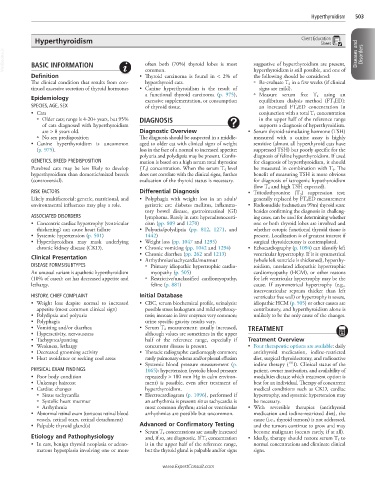Page 1022 - Cote clinical veterinary advisor dogs and cats 4th
P. 1022
Hyperthyroidism 503
Hyperthyroidism Client Education
Sheet
VetBooks.ir BASIC INFORMATION often both (70%) thyroid lobes is most suggestive of hyperthyroidism are present, Diseases and Disorders
common.
Definition • Thyroid carcinoma is found in < 2% of hyperthyroidism is still possible, and one of
the following should be considered:
The clinical condition that results from con- hyperthyroid cats. ○ Re-evaluate T 4 in a few weeks (if clinical
tinued excessive secretion of thyroid hormones • Canine hyperthyroidism is the result of signs are mild).
a functional thyroid carcinoma (p. 975), ○ Measure serum free T 4 using an
Epidemiology excessive supplementation, or consumption equilibrium dialysis method (FT 4 ED):
SPECIES, AGE, SEX of thyroid tissue. an increased FT 4 ED concentration in
• Cats conjunction with a total T 4 concentration
○ Older cats; range is 4-20+ years, but 95% DIAGNOSIS in the upper half of the reference range
of cats diagnosed with hyperthyroidism supports a diagnosis of hyperthyroidism.
are > 8 years old. Diagnostic Overview • Serum thyroid-stimulating hormone (TSH)
○ No sex predisposition The diagnosis should be suspected in a middle- measured with a canine assay is highly
• Canine hyperthyroidism is uncommon aged to older cat with clinical signs of weight sensitive (almost all hyperthyroid cats have
(p. 975). loss in the face of a normal to increased appetite; suppressed TSH) but poorly specific for the
polyuria and polydipsia may be present. Confir- diagnosis of feline hyperthyroidism. If used
GENETICS, BREED PREDISPOSITION mation is based on a high serum total thyroxine for diagnosis of hyperthyroidism, it should
Purebred cats may be less likely to develop (T 4 ) concentration. When the serum T 4 level be measured in combination with T 4 . The
hyperthyroidism than domestic/mixed breeds does not correlate with the clinical signs, further benefit of measuring TSH is more obvious
(controversial). evaluation of the thyroid status is necessary. for diagnosis of iatrogenic hypothyroidism
(low T 4 and high TSH expected).
RISK FACTORS Differential Diagnosis • Triiodothyronine (T 3 ) suppression test:
Likely multifactorial: genetic, nutritional, and • Polyphagia with weight loss in an adult/ generally replaced by FT 4 ED measurement
environmental influences may play a role. geriatric cat: diabetes mellitus, inflamma- • Radionuclide (technetium 99m) thyroid scan:
tory bowel disease, gastrointestinal (GI) besides confirming the diagnosis in challeng-
ASSOCIATED DISORDERS lymphoma. Rarely in cats: hyperadrenocorti- ing cases, can be used for determining whether
• Concentric cardiac hypertrophy (ventricular cism (pp. 809 and 1270) one or both thyroid lobes are involved and
thickening) can cause heart failure • Polyuria/polydipsia (pp. 812, 1271, and whether ectopic functional thyroid tissue is
• Systemic hypertension (p. 501) 1442) present. Localization is of greatest interest if
• Hyperthyroidism may mask underlying • Weight loss (pp. 1047 and 1295) surgical thyroidectomy is contemplated.
chronic kidney disease (CKD). • Chronic vomiting (pp. 1042 and 1294) • Echocardiography (p. 1094) can identify left
• Chronic diarrhea (pp. 262 and 1213) ventricular hypertrophy. If it is symmetrical
Clinical Presentation • Arrhythmias/tachycardia/murmur (whole left ventricle is thickened), hyperthy-
DISEASE FORMS/SUBTYPES ○ Primary idiopathic hypertrophic cardio- roidism, unrelated idiopathic hypertrophic
An unusual variant is apathetic hyperthyroidism myopathy (p. 505) cardiomyopathy (HCM), or other reasons
(10% of cases): cat has decreased appetite and ○ Restrictive/unclassified cardiomyopathy, for left ventricular hypertrophy may be the
lethargy. feline (p. 881) cause. If asymmetrical hypertrophy (e.g.,
interventricular septum thicker than left
HISTORY, CHIEF COMPLAINT Initial Database ventricular free wall) or hypertrophy is severe,
• Weight loss despite normal to increased • CBC, serum biochemical profile, urinalysis: idiopathic HCM (p. 505) or other causes are
appetite (most common clinical sign) possible stress leukogram and mild erythrocy- contributory, and hyperthyroidism alone is
• Polydipsia and polyuria tosis; increase in liver enzymes very common; unlikely to be the only cause of the changes.
• Polyphagia urine specific gravity results vary.
• Vomiting and/or diarrhea • Serum T 4 measurement: usually increased, TREATMENT
• Hyperactivity, nervousness although values are sometimes in the upper
• Tachypnea/panting half of the reference range, especially if Treatment Overview
• Weakness, lethargy concurrent disease is present. • Four therapeutic options are available: daily
• Decreased grooming activity • Thoracic radiographs: cardiomegaly common; antithyroid medication, iodine-restricted
• Heat avoidance or seeking cool areas rarely pulmonary edema and/or pleural effusion diet, surgical thyroidectomy, and radioactive
131
• Systemic blood pressure measurement (p. iodine therapy ( I). Clinical status of the
PHYSICAL EXAM FINDINGS 1065): hypertension (systolic blood pressure patient, owner motivation, and availability of
• Poor body condition repeatedly > 180 mm Hg in calm environ- modalities dictate which treatment option is
• Unkempt haircoat ment) is possible, even after treatment of best for an individual. Therapy of concurrent
• Cardiac changes hyperthyroidism. medical conditions such as CKD, cardiac
○ Sinus tachycardia • Electrocardiogram (p. 1096), performed if hypertrophy, and systemic hypertension may
○ Systolic heart murmur an arrhythmia is present: sinus tachycardia is be necessary.
○ Arrhythmia most common rhythm; atrial or ventricular • With reversible therapies (antithyroid
• Abnormal retinal exam (tortuous retinal blood arrhythmias are possible but uncommon. medication and iodine-restricted diet), the
vessels, retinal tears, retinal detachment) cause (i.e., thyroid tumors) is not addressed,
• Palpable thyroid gland(s) Advanced or Confirmatory Testing and the tumors continue to grow and may
• Serum T 4 concentrations are usually increased become malignant (occurs rarely, if at all).
Etiology and Pathophysiology and, if so, are diagnostic. If T 4 concentration • Ideally, therapy should restore serum T 4 to
• In cats, benign thyroid neoplasia or adeno- is in the upper half of the reference range, normal concentrations and eliminate clinical
matous hyperplasia involving one or more but the thyroid gland is palpable and/or signs signs.
www.ExpertConsult.com

